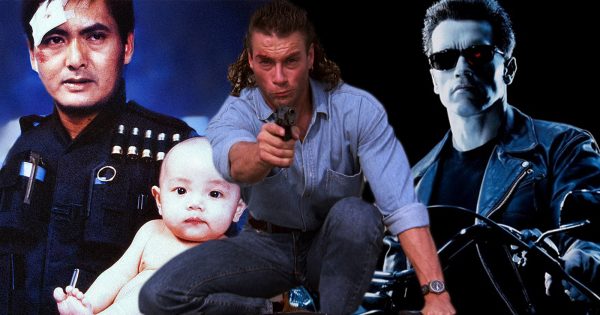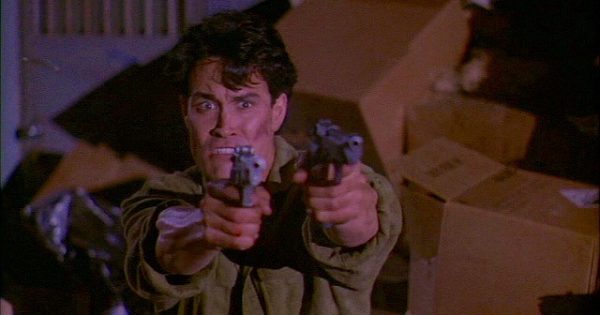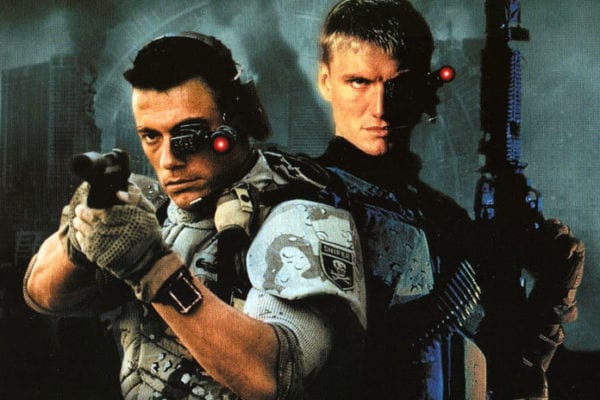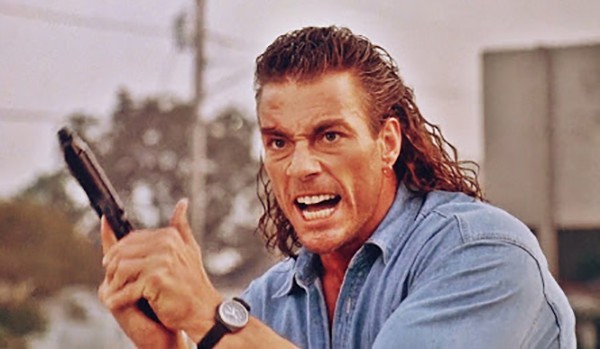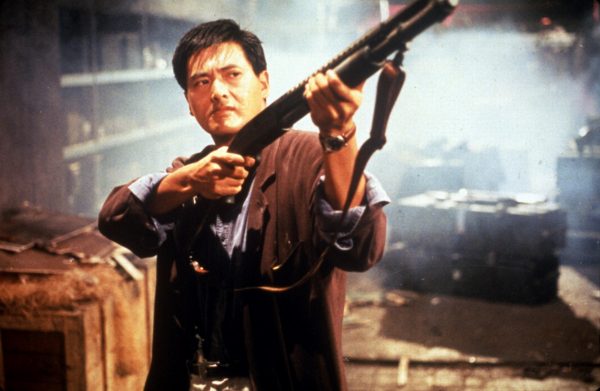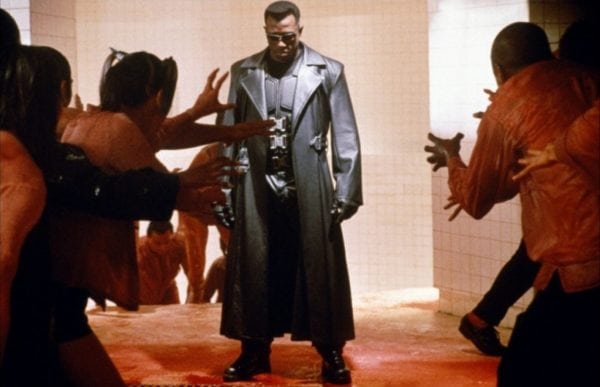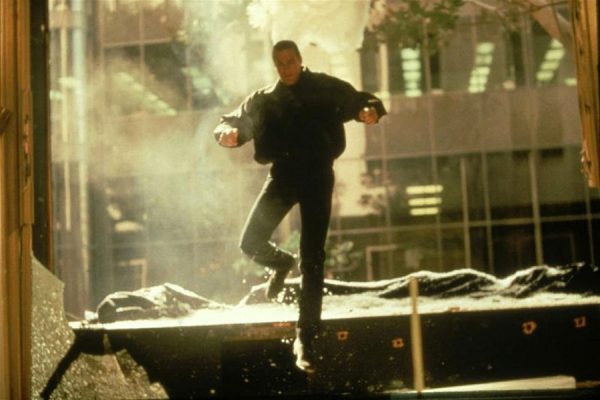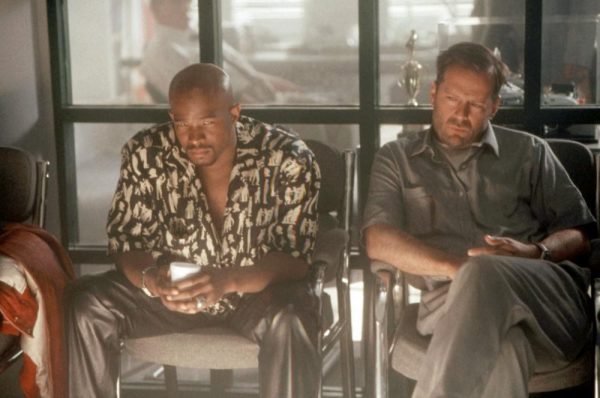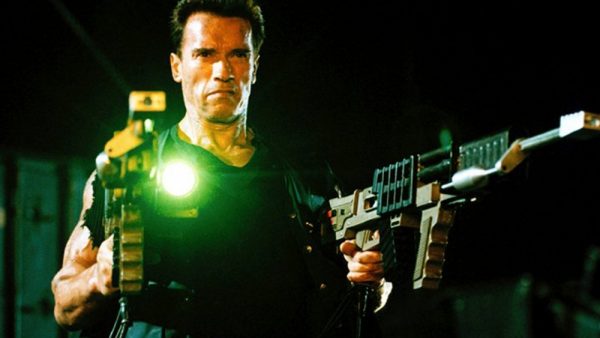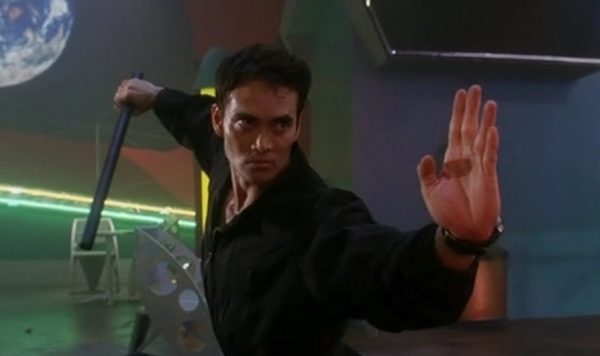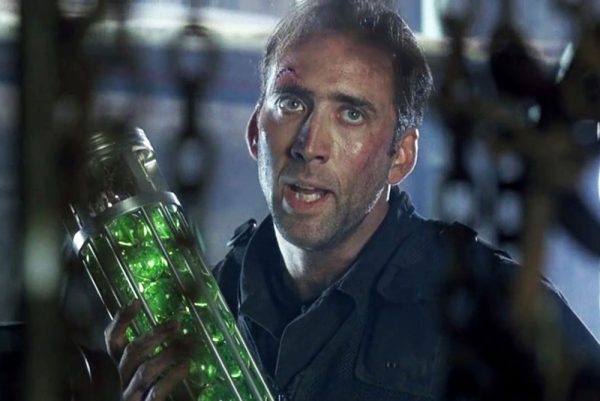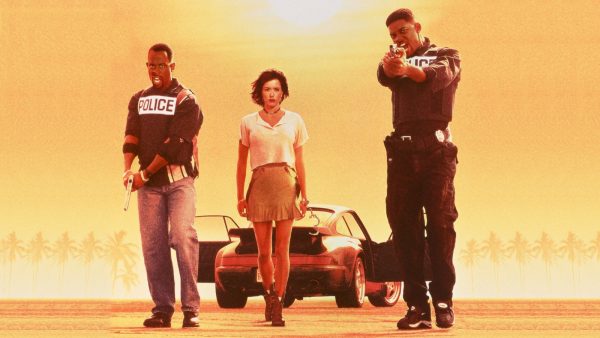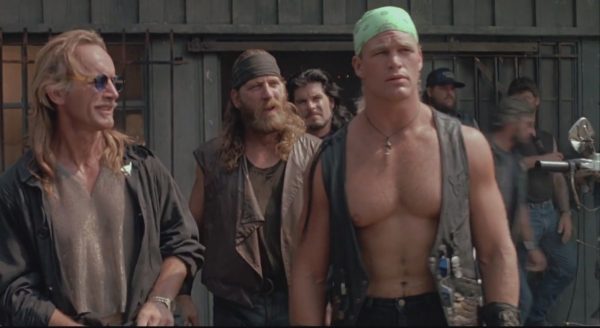Following our deep dive into 1980s action cinema, lock and load for our list of essential 1990s action movies…
The 1990s brought about a shift in the action genre. As the decade progressed there seemed to be shift from the 80s icons into the likes of Nicolas Cage and Keanu Reeves becoming action stars. Likewise the tail end of the century saw a push toward high concept material, a distinct influence from Hong Kong cinema, and a few music and fashion trends which bled into the material (from the costuming of the Matrix, to the soundtrack of Blade, some of these haven’t aged well).
Despite feeling somewhat transitional, it never felt like action films were being taken too seriously (like the post-Bourne era to come), and it was still often style over substance, plenty of spectacle, and still very reliant on practical FX. And so, here are some essential 90’s action films….
Rapid Fire and Showdown in Little Tokyo
Brandon Lee had everything going for him. He was good looking, charismatic, oozing with presence, great comical timing and he was a physical force. He sadly died right at the beginning of breaking out in a big way. It’s not hyperbole to suggest that Lee could easily have been THE action star of the 90s, and a decade or two beyond. He had the every man qualities, and emotional range to adapt to a changing market, as well as youth (in comparison to the majority of his contemporaries being born in the 40s or 50s).
Rapid Fire was the first to really showcase his abilities. It’s a hugely underrated action thriller which has Lee unwittingly thrown into a chaotic story of gangsters, crooked politicians, cops and Feds. The fights are superb, Lee is supremely likeable and the support cast, including Powers Boothe and Nick Mancuso, are great. Then there was Showdown in Little Tokyo.
If Commando had threatened to be the manliest film ever made a few years prior, then Mark L. Lester played a game of ‘hold my beer’ with himself as Showdown in Little Tokyo matches Commando stride for stride in sheer machismo lunacy. It’s as lithe as they come, full of one liners, brilliantly cheesy set pieces and a great double act in Dolph Lundgren and Brandon Lee. I’m the biggest Dolph fan going, but I’ll say it right now; Brandon steels the film at a canter. You could well argue there’s enough action in The Crow to be deemed essential too, so certainly throw that in, and it was Lee’s magnum opus.
SEE ALSO: The Brandon Lee Retrospective Triple Bill: Showdown in Little Tokyo, Rapid Fire and The Crow
Universal Soldier
If Brandon stole Showdown in Little Tokyo from his more established co-star Mr Lundgren, it’s certainly not because Lundgren lacked presence. In fact Lundgren does the very same thing to Jean-Claude Van Damme in the poundingly-fun B movie classic Universal Soldier.
Universal Soldier plunders from an array of sources, but moulds everything into a fun and large scale package. In fact it looks far beyond what was actually a very modest budget, in what remains Roland Emmerich’s best film. Van Damme was firmly on the rise, whilst Lundgren was stagnating as a leading man. Lundgren chews scenery and slices ears as the villain. Van Damme has a puppy dog innocence and endearing quality that makes him very likeable here too. It’s funny, the set pieces are great and it has two action titans facing off in their prime.
SEE ALSO: Revisiting the Universal Soldier Franchise
Hard Target and Timecop
Van Damme’s mulleted double whammy of Hard Target and Timecop followed Universal Soldier beautifully, a run of hits that put him right up with the big boys.
Hard Target is hands down Van Damme’s crowning glory. Other films are certainly more iconic, and more associated with his career breaking specialities of tournament fight films, but Hard Target has stepped to the fore front as time has moved on. It’s the last pure John Woo flick. It’s Woo’s brutally balletic best, full of relentless gunplay but also filled with some of the most effective displays of Van Damme’s patented kicks. The soundtrack is cool, and Van Damme comes up against a duo of really brilliant villains in Arnold Vosloo and Lance Henriksen. The action is relentless, loaded with squibs, sparks and blood packs. It’s almost archaic in how impressively practical it all looks.
Timecop meanwhile has often been accused of having plot holes up the wazoo, but in an age of MCU incoherence where high concept plots involving time lines (or multiverses) need no logic at all, Timecop suddenly looks more controlled in comparison. In truth, we’re here for the high kicking action and Timecop is a lot of fun. Ron Silver, in an era of great action villains, really enjoys himself.
SEE ALSO: Van Damme meets Tsui Hark: Double Team and Knock Off
Hard Boiled
Best action film of the decade, and one of the best of all time. John Woo had perfected his style here. There’s an engaging story, complex characters and two really charismatic leads. Chow Yun-fat and Tony Leung were like the Al Pacino and Robert De Niro of Hong Kong cinema, and their charisma and physical grace is only exceeded by their emotional range and nuance.
Woo loves tales of duality and he creates an enthralling rivalry between the two which arks into a reluctant team up. Heroic bloodshed is in the offing, with set pieces that redefined on screen shootouts. The cohesion of stunt man lunacy, dazzling (and chaotic) pyrotechnics and Woo’s shooting and cutting, creates action perfection. Hard Boiled’s action still amazes and those set pieces will never be surpassed in the CGI era. Michael Gibb’s score is also excellent.
SEE ALSO: From Hard Boiled to Soft Boiled: Why John Woo’s masterpiece will never be matched again
Demolition Man, Cliffhanger and Assassins
Send a maniac to catch one. Demolition Man has been a film I’ve loved from day one. It was moderately successful but still felt like a picture exemplifying Sylvester Stallone’s fallen star power. The box office was a world away from his peak in the mid 80s when he could boast having Rocky IV and Rambo: First Blood Part II coming out in the same year and ending up as two of the top five highest grossing films of 1985. Demolition Man is great though. Funny, action packed, exciting and it has aged particularly well thanks to an array of successful predictions about where society was heading. Wesley Snipes is superb too.
Cliffhanger marked Sly’s last major success of the decade, and the Die Hard in the mountains plot had plenty of scope and stunning photography. Assassins, the least successful of the three in every facet, still has plenty going for it. The Wachowski-penned script retained enough semblance of the siblings abilities’ to suggest the break coming their way and Richard Donner provides solid direction. It just sags in a bloated middle where Julianne Moore’s character slows the film down. If there’s one thing to say about all three, it’s that Stallone gets a little overshadowed by some of his co-stars like John Lithgow, Michael Rooker, Wesley Snipes and Antonio Banderas.
SEE ALSO: Sylvester Stallone: The Unstoppable Force
Passenger 57 and Blade
Speaking of Wesley Snipes…he started the decade as a promising and acclaimed character actor. He ended it as one of the primo action stars. Passenger 57, a really sleek and lithe Die Hard on a plane riff, was a great, if light, showcase for Snipes’ blistering brand of on screen fighting (utilising his martial arts skills). It’s got great lines, a slimily brilliant bad guy in Bruce Payne, and a badass leading man.
A few more so-so action films came and went for Snipes, but then he had a massive breakout with Blade. It launched a franchise and also paved the way for Marvel to finally find success on the big screen. The opening 30 minutes of Blade are the best material committed to any Marvel property. The rest of the film can’t quite maintain it, but Blade, despite the occasionally grating soundtrack (Mark Isham’s score is great though) has aged well.
SEE ALSO: The 1990s in Comic Book Movies
Marked for Death, Out for Justice and Under Siege
Steven Seagal hit the action world by storm somewhat. He followed Above the Law with a triple hit of slightly interchangeable projects, the weakest probably being Hard to Kill (even though Quentin Tarantino heavily riffs on it in Kill Bill). Out for Justice was great though, proving one of the best platforms for Seagal’s on screen fighting and stoic presence. It’s ruthlessly simple and brutally violent, as Seagal hunts down a psychotic mobster on a rampage who killed his partner. There’s no bells and whistles, or some of the espionage driven subplots we’ve seen in other Seagal pictures, it does what it says on the tin. William Forsythe is immense as the deranged Richie, whilst Seagal gives his best performance. The film features the greatest bar action scene ever too.
Under Siege became Seagal’s first mega hit and a film that felt larger in scale than his previous ones. It’s bolstered by superb villains with Tommy Lee Jones and Gary Busey. The only problem being, that Seagal does get a little overshadowed, and there are less fight scenes than his other early works. It is a great Die Hard riff however. For me though, I’m increasingly fond of Marked For Death. There’s an added air of mysticism and intrigue as Seagal takes on a Jamaican drugs gang lead by Screwface (a man with a black magic fascination). There are some exceptional fight sequences too and Basil Wallace makes for a unique and intense villain.
SEE ALSO: The Film Feud of the 90s: Steven Seagal vs Jean-Claude Van Damme
The Last Boy Scout and Die Hard With A Vengeance
Bruce Willis teams with Tony Scott and Shane Black. The result is The Last Boy Scout, a somewhat overlooked buddy up film that isn’t quite Lethal Weapon but great none the less. As you’d expect from Shane Black our mismatched duo enjoy firing insults and one liners at each other to great effect. Willis and Damon Wayans have a good buzz between them and Willis plays a good variation on his McClane role. Tony Scott provides atypically stylish visuals and slick action too.
In 1995, Willis also had a third Die Hard film which sensibly opted to take things slightly away from the formula of the first film. It’s a great little cat and mouse thriller with bursts of large scale action. Die Hard With a Vengeance is easily the best sequel, and in actuality one of the most enjoyable action flicks of the decade… I mean, it did make this list.
SEE ALSO: The Best of Bruce Willis
Point Break, Speed and The Matrix
Everyone’s favourite person Keanu Reeves came into his own as an action star in the 90s, in a real push to step away from the impression Ted Logan indelibly left on him.
Point Break is a gloriously stylish macho action film, shot by a female director. It looks and feels unique for its period and it is underpinned with a little depth beneath the waves. Reeves is perfectly two dimensional as the ex football star turned fed, now working undercover to infiltrate the surfing community (to root out a criminal gang of extreme sport enthusiasts). His character is young, dumb and full of…ahem…Reeves retains enough of his simple ‘whoa’ demeanour from Ted. Patrick Swayze burns with charisma, with a unique and engaging ‘villain.’
Reeves followed Point Break with a character who was brash and macho, but with an ability to troubleshoot on the spot, with intelligent instinct. Speed proved to be a monster hit with a simple but brilliantly effective. Does it lose it’s way once the bus is out of the picture? A little, but Speed is still absolutely frigging brilliant to watch and Reeves is great, really throwing himself physically into the role. The Matrix would not only cement Reeves as an exceptionally dedicated and hard working talent, but it would also prove to be a major game changer in the genre. The Matrix, as much as it owed to an array of films before it, inspired a decade of action films that followed, not least in its use of wire work and martial arts.
SEE ALSO: None More Nineties: Why Speed is the ultimate 90s action film
Total Recall, Terminator 2: Judgement Day, True Lies and Eraser
The four quintessentially Ahnuld action films of the 90s, were also a perfect line graph that showed his dwindling appeal. He began the decade firing out two genre greats in Total Recall and Terminator 2. Recall had all the humour, sleaze and excessive violence expected of Paul Verhoeven, but it also had mystery, intrigue and absolutely brilliant design. In fact I’d go as far to say that pound for pound there’s not a lot between Recall and T2 as far as overall quality.
However, when it comes to pure action spectacle, rising stakes and elevated stages of action, then T2 is unsurpassed in the decade. It’s very existence has an under-layer of slight cynicism, particularly in including a young protagonist to appeal to younger audiences (though it’s still firmly R rated) and opening up a story that had succinctly been closed in the first. It’s not as lithe, gritty and perfectly paced as the more horror-centric original, but for big action, Terminator 2 probably hasn’t been matched in Hollywood cinema since. It’s use of CGI was not just groundbreaking but perfectly rationed and effective. The scale of set pieces is immense and stunt work particularly impressive. Much of this would just be made with CGI these days (like the stunning helicopter/van freeway chase).
True Lies has been almost wiped from public consciousness in 28 years and has regrettably old fashioned (even back then) depiction of middle eastern villains, but the set pieces are stunning, the film is hilarious and it’s a hell of a lot of fun. Jamie Lee Curtis and Tia Carrere make the movie perhaps even more so than Schwarzenegger (though his double act with Tom Arnold strikes gold consistently). Eraser would prove to be the last all out Arnie action film ever made. He was just at the end of his prime physically, still great and imposing. There are big set pieces and the late great James Caan is a fantastic villain.
SEE ALSO: When Arnold Schwarzenegger prevented the End of Days
Drive and Crying Freeman
Mark Dacascos had a lot of potential. He had a vulnerability that made him a little different to his contemporaries. He was a physical dynamo with gymnastic skills and martial arts combining beautifully on screen. On top of that he was a solid actor too. He flirted with the big screen but didn’t have that lucky hit or break that gave him a consistent run.
Crying Freeman remained unreleased in the US for around 20 years and only found its way on streaming eventually. Based on the popular Manga, the low budget but beautifully shot film was a stylish mix of John Woo style action and balletic martial arts fight scenes. Dacascos glides across the screen beautifully, and a bit of emotional sincerity and chemistry with his soon to be wife Julie Condra. The film does successfully what many action films can’t always, and that’s to tell a story visually with very little dialogue, in much the same way as Conan The Barbarian and Highlander successfully did. A big part of it, much like those aforementioned, is down to the haunting, beautiful score by Patrick O’Hearn. No one outside France and Asia has seen the film, which is a shame, and O’Hearn’s work is particularly great.
Drive, which also evaded cinemas in the US, did at least prove popular on cable. The low budget martial arts classic that could was actually groundbreaking. It’s just not enough people noticed it. It’s probably the first film to effectively utilise Hong Kong style action in a Western, English language film. Steve Wang and the Alpha Stunt team craft imaginative, dynamic action which fully utilises Dacascos’ talents. Beyond fighting, it’s a fun mismatched buddy film with quirky characters littered throughout. The chemistry between Dacascos, Kadeem Hardison and the late Brittany Murphy is sublime. John Pyper Ferguson also revels in his villainy.
The Rock, Con Air, and Face/Off
We all love a bit of Nic Cage. The unique talent he is, he has garnered a big group of fans due to his shift into the action genre in the mid 90’s. It was an unexpected move, but one that proved to be career redefining. The qualities of Cage added a unique presence in the genre and he had a solid decade of pumping out blockbuster hits.
The Rock is still his magnum opus and the most perfect example of Bayhem. Cage teams with Sean Connery who is so unspeakably and effortlessly cool here, that he barely breaks sweat to own the film. Cage is great, and he brings a quirky quality as Goodspeed, but Connery was as magnetic as anyone on screen. Bay’s film is fast, frantic, but big, bold and exciting. Con Air has plenty of that Bruckheimer scale and histrionic silliness, as well as an eclectic cast of villains (headed up by John Malkovich), even if it’s not quite as good as The Rock.
Face/Off proved to be John Woo’s last great movie, and one which also saw him becoming a caricature of himself. Woo, maybe unintentionally, sends himself up in a film that’s almost head thumpingly daft, but it somehow works. It works because despite the silliness and the cheesy styling, Nick Cage and John Travolta are pitched in a perfectly complimentary battle of one upmanship scenery chewing. Face/Off shouldn’t have worked but that Pastiche Woo/Cage/Travolta formula is dynamite.
SEE ALSO: Michael Bay’s Crowning Glory: The Rock
Bad Boys
Michael Bay’s first film, Bad Boys burst out of the blocks with rapid fire dialogue, blistering set pieces and a cast with a difference. A comedic double act of Martin Lawrence and Will Smith works beautifully, whilst Smith’s shift from sitcom star to action hero is smooth as silk. Bad Boys might have roughened in age, but it still moves at breakneck pace, and despite Bay’s complete lack of subtlety, the film is coherent in comparison to his future works. In 1995 this blew me away. It was genre redefining to every 13 year old across the western world. Okay, we might have quickly outgrown it, but there’s still so much fun to be had in Bad Boys. The sequels, not so much.
Stone Cold
If you want a film which cranks the insanity up to eleven, with almost Paul Verhoeven levels of gleefully bloody violence, then look no further than Stone Cold. A burly cop, played by Brian Bosworth (aka ‘the Boz’) goes undercover to infiltrate a criminal gang of bikers headed by Lance Henriksen (once again, a magnetic villain). Bosworth has the kind of range and presence that John Cena has since shown in his action films. Make of that what you will, but the film rockets along from daft set piece to dafter set piece and it’s a stunt man’s dream. It’s crazy but it’s gloriously (and often knowingly) stupid. Craig R Baxley had a gift for crafting destructive and impressive action on a small budget. Stone Cold fully utilises the former stunt man’s nous with physical falls, ratchet pulls, bar brawls and an array of vehicular carnage.
Rumble in the Bronx and Rush Hour
Jackie Chan was at his action peak in the 80s but still going strong in the 90’s. After some false starts, a break into America was inevitable. Rumble in the Bronx paved the way. Though Hong Kong produced, it was an East/West fusion, which saw Chan as a fish out of water sent to help a relative in the Bronx, set up a new store. Rife with crime, Chan finds himself running afoul of a local gang. Fights brimming with creativity, comedy and super stunt work are Chan specialties and they’re in full evidence here. Rumble in the Bronx is great fun. It had enough of an impact in the US to pave the way for Rush Hour. A simple buddy film which brings Chan to the Western market at perhaps fourth gear, but still full of beans. Chan and Chris Tucker have a great on screen rapport and the film is pure entertainment.
SEE ALSO: The Essential Jackie Chan Movies
What is your favourite 90s action film? Let us know on our social channels @flickeringmyth…
Tom Jolliffe is an award winning screenwriter and passionate cinephile. He has a number of films out around the world, including When Darkness Falls and Renegades (Lee Majors and Danny Trejo) and more coming soon including War of The Worlds: The Attack (Vincent Regan) and The Baby in the Basket. Find more info at the best personal site you’ll ever see here.
